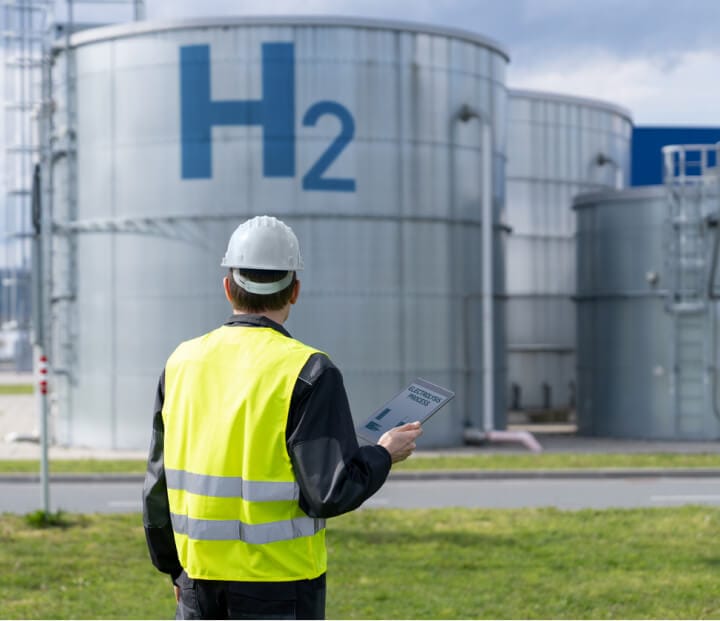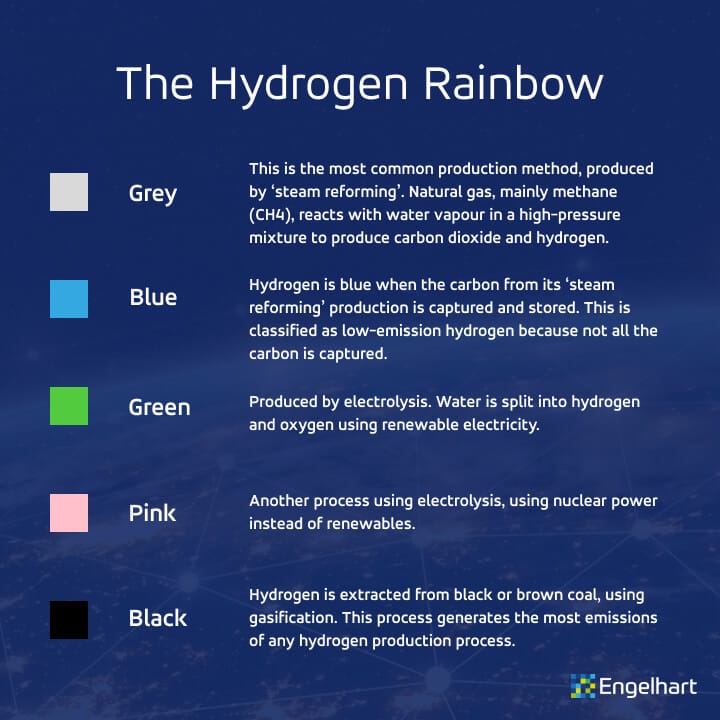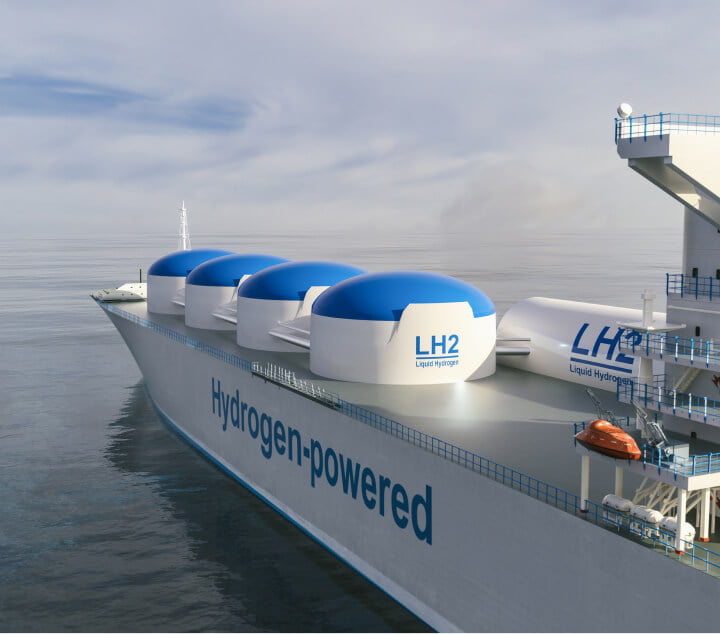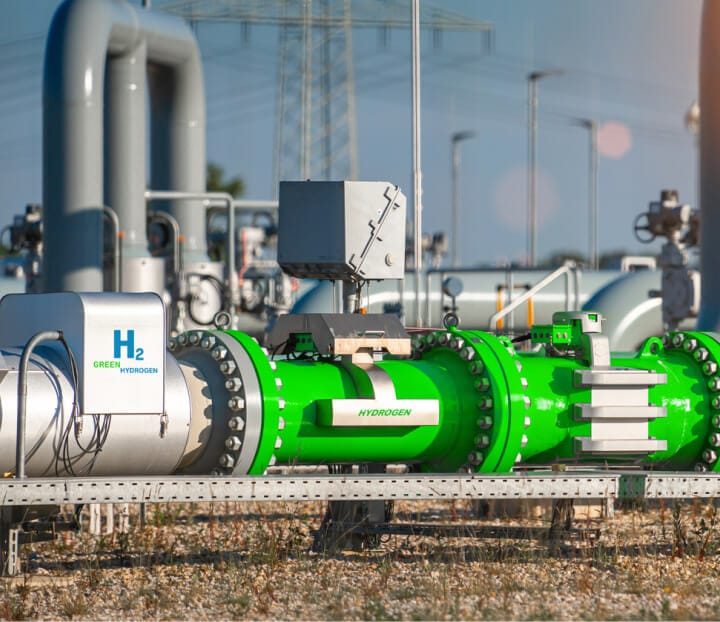
Could hydrogen be the next global commodity?
Hydrogen has long been a “fuel of the future”. Since the first use of hydrogen fuel in an internal combustion engine in 1806 by Swiss inventor François Isaac de Rivaz, engineers have looked for ways to convert hydrogen into energy.
On the surface, hydrogen seems like the perfect alternative in a decarbonising world. It’s light, storable, energy-dense (by weight), and produces no direct emissions of greenhouse gases (GHGs). But it can also be energy and carbon-intensive to extract, costly to produce, and challenging to transport in its natural form.
Until recent years, these factors and cheaper and more accessible alternatives have limited the interest and investment in hydrogen as energy, but that’s now slowly changing.

A new age of hydrogen
We’ve entered a new age of hydrogen. Governments and policymakers are beginning to offer financial support and incentives for green and blue hydrogen projects, which use renewable energy and carbon capture in their extraction processes.
These colours of hydrogen are increasingly viewed as having high potential as a critical part of the energy transition, helping decarbonise high-polluting sectors, including heavy industry, transport and energy. However, green and blue hydrogen are still a negligible part of the overall mix today. Most hydrogen is still produced from natural gas or coal; green and blue hydrogen production in 2022 was only 0.7% of global production, almost entirely from fossil fuels with carbon capture.
Today, hydrogen is primarily used as a feedstock for industrial processing, producing ammonia for fertilisers, and refining crude oil. Less than 0.1% of that demand in 2022 came from new sectors like transport or power generation.
Hydrogen does offer flexibility to decarbonise parts of the global energy economy, which renewables can’t reach. As an energy carrier, it also creates a tangible possibility of creating a tradeable market in renewable energy. But widespread adoption is far from certain, and it will need a concerted effort by governments and market participants to lower production costs, create a regulatory framework, and make a better case for hydrogen as an alternative to fossil fuels.
Seasoned energy market players will probably shake their heads and say we’ve been here before.
However, the question we want to explore in this blog is whether this is the moment hydrogen realises its potential.
Can hydrogen overcome significant barriers to developing into a globally traded commodity rather than remaining a local alternative to traditional energy?

Potential hydrogen uses
The utility of green hydrogen as an energy vector is clear. It has great potential as an energy carrier to store and transport renewable energy. However, it could also be used as a fuel and industrial feedstock to help decarbonise multiple sectors, from domestic heating to industry and transportation.
Domestic
There has already been some progress in using hydrogen as a replacement for natural gas in domestic heating and cooking. Manufacturers are making “hydrogen-ready” boilers, and one of the first hydrogen blending projects has been launched in the U.S. The HyGrid Project in Long Island is using existing natural gas infrastructure to blend hydrogen with gas to provide energy solutions with lower emissions.
Energy providers also explore using hydrogen to add resilience to power grids by storing renewable energy.
The challenge is that the current cost of producing green hydrogen remains prohibitive for domestic use, especially compared with other alternatives such as heat pumps or solar thermal.
Industry
Green and blue hydrogen are already playing a small role in decarbonising parts of heavy industry, like refining. However, that needs to accelerate rapidly to make any meaningful contribution to lowering emissions across global industry.
Green hydrogen has potential use cases in steelmaking, as a replacement for coal in the blast furnace, and in the chemical industry in the ammonia and methanol production. But again, more investment in infrastructure and production is needed to ensure widespread adoption.
A recent EU study suggested that completely replacing coal with hydrogen in steelmaking would increase the cost of a ton of steel by a third.
Transportation
Hydrogen is currently used in some limited road transportation globally, but that is increasing. Fuel cell electric vehicles (FCEVs), which produce electricity using a hydrogen fuel cell, are now being used in some countries, including China and India, as buses and heavy goods vehicles.
Although FCEVs have some advantages over regular electric vehicles, such as range and refuelling speed, the lack of refuelling infrastructure and access to green hydrogen at scale is dampening demand.
Hydrogen is also being explored as an alternative fuel in shipping and aviation, most notably in synthetic kerosene for aircraft and its pure form and ammonia as a marine fuel.

In almost every potential use case, the production cost of extracting green and blue hydrogen is the most significant barrier to adoption. The benefits are clear, but much more work must be done to make the fuel viable across the energy and industrial complexes.
The reality of trading hydrogen
A global market would allow countries with limited domestic capability to import hydrogen and diversify away from fossil fuels. This would lower emissions and improve energy security; it would also create price signals for countries to ramp up production. However, the global hydrogen trade is still only in its infancy. Active trade flows are limited to a handful of pipelines in parts of Europe (with plans to add 2,500km more in the next four years) and some pilot projects – led by Japan – to test hydrogen trade by ship.
This is insignificant in the context of what must happen for hydrogen to have a meaningful role in the clean energy transition. The International Energy Agency (IEA) ‘Net Zero Emissions by 2050 Scenario (NZE)’ estimates that Net Zero needs a hydrogen trade in which more than 20% of demand for the fuel is met through global trade by 2030. That’s a big ask, and there are currently many hurdles to overcome before that becomes a reality:
Cost of production
Inflation is increasing the cost of capital needed to invest in green and blue hydrogen projects. One example is Saudi Arabia’s NEOM Green Hydrogen project – which is set to produce 1.2 million tonnes of green ammonia annually. Its total capital needs have risen from $5 billion to $8.5 billion.
The cost of installing electrolysers at scale limits supply, and the production of green hydrogen is also closely related to the cost of the energy needed to power the electrolyser.
The overall cost of low-emission hydrogen should reduce over time as inflation eases and government financial support trickles down, but that must accelerate if hydrogen is to become as competitive as other energy alternatives.
Lack of demand
Production is just one side of the equation. Scaling a global hydrogen trade also needs sufficient demand for clean hydrogen. Until now, government subsidies have focused predominately on the supply side. The International Energy Agency (IEA) recently noted:
“The sum of all government targets for low-emission hydrogen production accounts for 27-35 million tonnes (Mt) today, but targets for creating demand account for just 14 Mt, less than half of which is focused on existing hydrogen uses.”
Substituting the most common grey hydrogen with green or blue would seem like the most obvious first step for increasing demand for low-emission hydrogen. However, that will require financial support from governments and more transparent pricing from producers. A more cohesive global approach to carbon pricing would also help create demand for green hydrogen, as there would be a greater financial incentive for the most polluting industries to look for alternatives to fossil fuels.
Technology and Infrastructure
One of the most significant sticking points of a global hydrogen trade is the challenge of transporting the molecule and the lack of suitable infrastructure like pipelines, terminals and specialised ships. Liquid compressed hydrogen must be stored at extremely high pressures (350-700 bar) or extremely low temperatures (-253°C).
There have been advances in hydrogen transportation and storage in recent years, particularly in using ammonia as a carrier and developing liquid organic hydrogen carriers (LOHCs), oil derivatives that can store and release hydrogen. These options benefit from being compatible with existing infrastructure but require additional costs and emissions to convert them back into hydrogen fuel.

Regulation and Policy
A global tradeable hydrogen market will struggle to develop until a regulatory framework and certification process are agreed upon. Market participants must be confident that green and blue hydrogen emissions are as low as the counterparty claims they are.
Lessons from LNG
The early stages of the global hydrogen trade have clear parallels with how the trade in LNG has grown in recent decades. The LNG market has evolved from direct shipments from supplier to customer to a thriving and diverse global trade that’s become essential to the world’s energy security following the Russian invasion of Ukraine.
The success of the LNG trade is underpinned by government support and long-term contracts with clauses guaranteeing minimum supply. This mitigates the risk of investing in production and transport infrastructure. Any global hydrogen trade would need similar support and certainty to create sustainable foundations for growth. What we’re seeing now with low-emission hydrogen is that countries with abundant renewable resources and the geographical capacity to build the infrastructure, such as Australia and Saudi Arabia, are already entering into supply agreements with countries where clean hydrogen production costs are prohibitive, like Japan.
The Japanese shipbuilder Kawasaki Heavy Industries, Ltd. has been testing the first liquid hydrogen tanker since 2022 and expects the first commercial vessel to transport liquid hydrogen by mid-decade.
The expectation is that most seaborne hydrogen will be carried in green ammonia, which is considerably cheaper to transport but not without its sustainability challenges.
We’ve also seen investments in new hydrogen pipelines in Europe, the U.S. and the Middle East. This first stage of “point to point” trade is similar to how LNG began in the 60s and 70s.
“The LNG industry has been built on the back of contractual frameworks that reduce risk and encourage investment”
International Energy Forum
The challenges ahead
The challenges for developing a global trade in low-emission hydrogen are clear, but what also seems likely is that hydrogen will become a real energy commodity at some point.
The barriers are high, but the momentum behind developing green and blue hydrogen from governments and energy companies should prove too decisive in the medium and long term.
The most critical challenge will be getting the balance and timing right. We can’t afford hydrogen to become a fig leaf for countries and industries to keep burning fossil fuels indefinitely.
Instead, there needs to be a coordinated approach to reducing the cost of green hydrogen production, investment in infrastructure and transport, and greater certainty around policy and regulation.
Hydrogen may have had its time in the sun before, but this time feels different.
The “fuel of the future” is now becoming a clean energy alternative in the here and now.
However, despite the optimism, there’s still a challenging journey ahead for it to become a truly global commodity. The future may be slowly getting brighter for international trade in green hydrogen, but as with so much of the clean energy transition, time is already running out.
